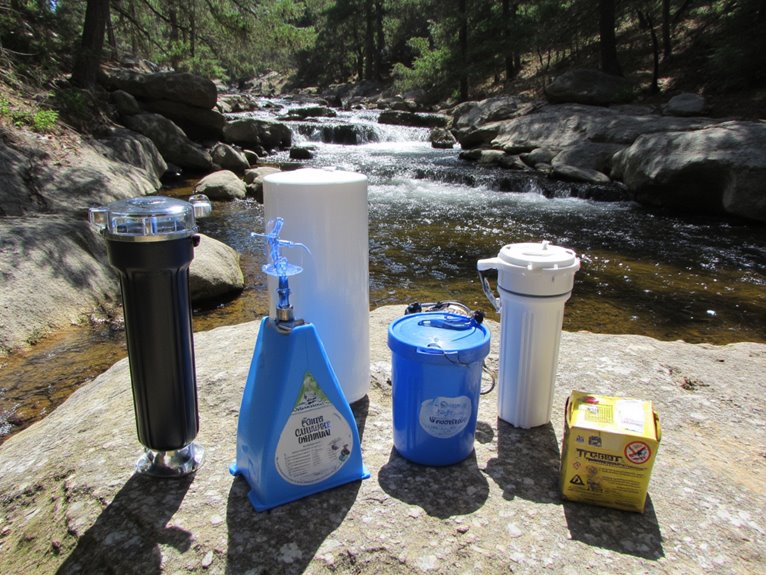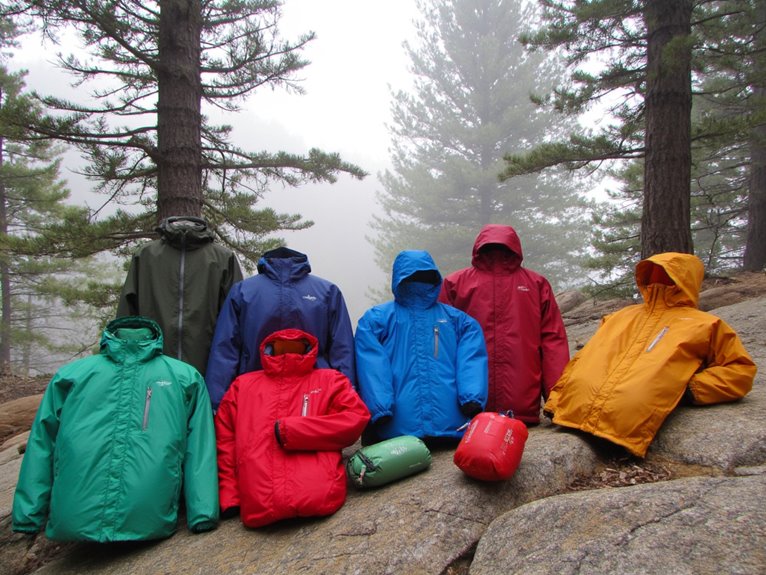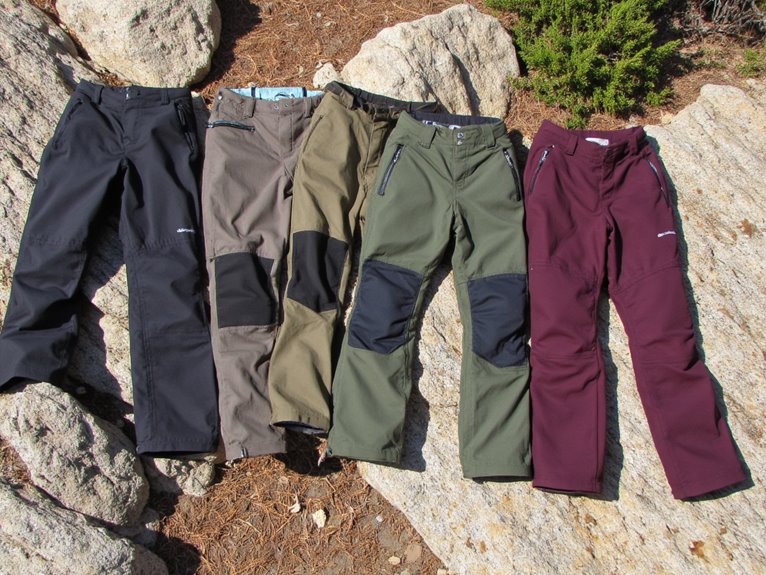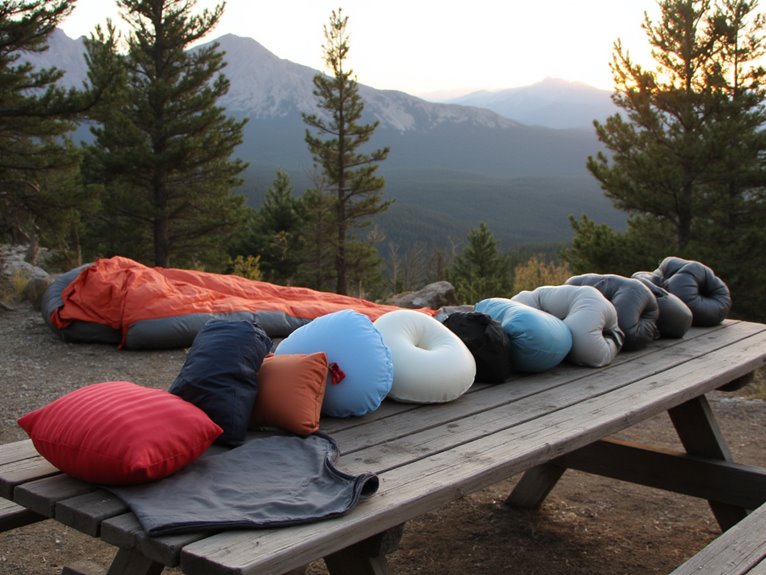Best Water Purification Systems for Backpacking
I’ve identified the top water purification systems that excel in wilderness conditions: the GRAYL GeoPress delivers 24 oz of purified water in under a minute, eliminating viruses and bacteria without pumping. Aquatabs tablets treat 4 gallons in 30 minutes with 99.9999% bacterial elimination. The Waterdrop Gravity Filter processes 700 ml/minute through its 0.1-micron membrane, weighing just 4.64 ounces. Each system offers distinct advantages for specific backpacking scenarios and water sources you’ll encounter.
We are supported by our audience. When you purchase through links on our site, we may earn an affiliate commission, at no extra cost for you. Learn more. Last update on 26th November 2025 / Images from Amazon Product Advertising API.
Notable Insights
- GRAYL UltraPress purifies 16.9 ounces in 10 seconds, eliminating 99.9% of viruses and bacteria with easy operation.
- Waterdrop Gravity Filter Straw provides 1,400 gallons of filtration with fast 700 ml/min flow rate at 4.64 ounces.
- Sawyer Products Squeeze filters 99.99999% of bacteria and 99.9999% of protozoa with lightweight, portable design.
- Aquatabs tablets treat 4 gallons per tablet in 30 minutes, killing 99.9999% of bacteria with no aftertaste.
GRAYL GeoPress 24 oz Water Purifier Bottle (Coyote Brown)
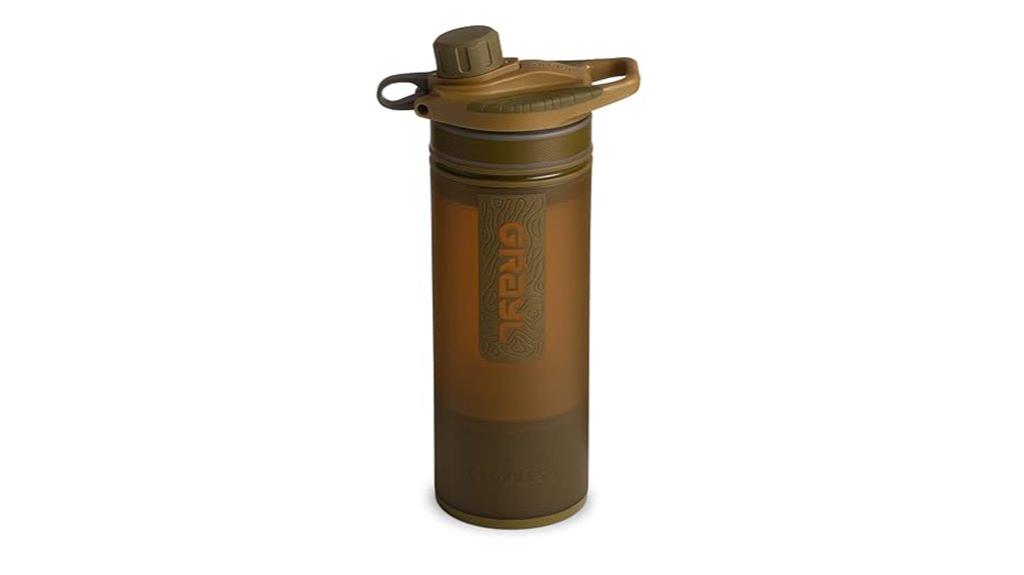
When you need reliable water purification that doesn’t require pumping, waiting, or carrying multiple components, the GRAYL GeoPress 24 oz Water Purifier Bottle delivers thorough filtration in a single press-and-drink system. You’ll eliminate viruses, bacteria, protozoa, VOCs, PFAS, heavy metals, and microplastics from any questionable water source in under a minute.
The replaceable cartridge handles 65 gallons before requiring replacement. You’ll find the operation straightforward: fill, press down, and drink. The design separates dirty water from clean water effectively.
Some users report increased pressing difficulty over time and question the stated cartridge lifespan. You’ll need moderate physical strength to operate it consistently. The system won’t handle tannin-rich water sources effectively, limiting use in certain environments.
Best For: Outdoor enthusiasts, travelers, and emergency preparedness who need reliable water purification from questionable sources without pumps or chemicals.
Pros:
- Purifies 24 oz of water in under a minute with comprehensive filtration removing viruses, bacteria, chemicals, heavy metals, and microplastics
- Simple one-step operation requiring only filling, pressing, and drinking with clear separation between dirty and clean water
- Long-lasting replaceable cartridge handles 65 gallons making it ideal for extended trips and emergency kits
Cons:
- Requires moderate to significant physical strength to operate, with pressing difficulty increasing over time
- Some users report filter efficiency dropping before the stated 65-gallon cartridge lifespan
- Cannot effectively handle tannin-rich water sources, limiting use in certain environments
Aquatabs Water Purification Tablets (100 Pack) for Camping & Emergencies

Aquatabs Water Purification Tablets deliver laboratory-grade water treatment in a compact format that’s perfect for backpackers who need reliable disinfection without the weight penalty of traditional filtration systems. Each 397mg tablet treats four gallons of water in 30 minutes. The formula eliminates 99.9999% of bacteria, 99.99% of viruses, and 99.9% of cysts including Giardia. You’ll appreciate the neutral taste profile—no chemical aftertaste like iodine-based alternatives. The 100-tablet pack provides extensive coverage for extended trips. These tablets store easily in your pack without adding significant weight. They’re shelf-stable until April 2026, making them excellent for emergency preparedness.
Best For: Backpackers, campers, and emergency preparedness enthusiasts who need lightweight, effective water purification that doesn’t compromise on taste or require heavy filtration equipment.
Pros:
- Highly effective against bacteria (99.9999%), viruses (99.99%), and cysts (99.9%) including Giardia
- Lightweight and compact design with no unpleasant taste, color, or odor unlike iodine-based alternatives
- Long shelf life until April 2026 and treats large quantities of water (4 gallons per tablet)
Cons:
- Requires 30-minute waiting period before water is safe to drink
- Chemical treatment method may not appeal to those preferring mechanical filtration
- Each tablet treats a large volume (4 gallons) which may be excessive for individual use
Waterdrop Gravity Water Filter Straw, Camping Water Filtration System
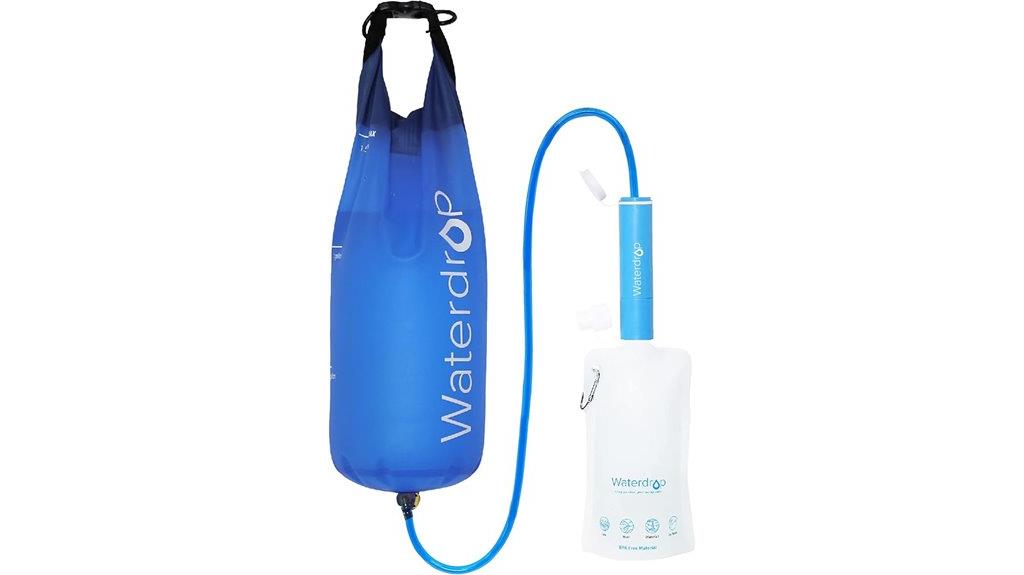
The Waterdrop Gravity Water Filter Straw delivers 1,400 gallons of filtration capacity through its 5-stage purification system, making it an ideal choice for extended backpacking trips where reliable water treatment is essential. You’ll benefit from its 0.1-micron ultrafiltration membrane combined with coconut shell activated carbon, which removes chlorine, sediment, and harmful particulates while eliminating bad taste and odor.
The system weighs just 4.64 ounces and processes water at 700 ml per minute through gravity feed. You can attach it directly to the included 1.5-gallon bag or standard water bottles. The innovative backwash function maintains filter performance throughout its lifespan, ensuring consistent water quality on multi-day adventures.
Best For: Backpackers, campers, and outdoor enthusiasts who need reliable water filtration for extended trips and emergency preparedness situations.
Pros:
- High-capacity 5-stage filtration system that processes up to 1,400 gallons with effective removal of chlorine, sediment, and harmful particulates
- Lightweight at 4.64 ounces with fast 700 ml/min gravity-fed flow rate, making it ideal for portable outdoor use
- Innovative backwash function maintains filter performance and extends lifespan while offering versatile connection options for water bags or bottles
Cons:
- Requires strategic positioning when water sources are low due to gravity-fed design limitations
- Potential for hose connection leaks to develop over extended use
- 30-day limited filter warranty is relatively short compared to the product’s claimed filtration capacity
Squeeze Water Filtration System
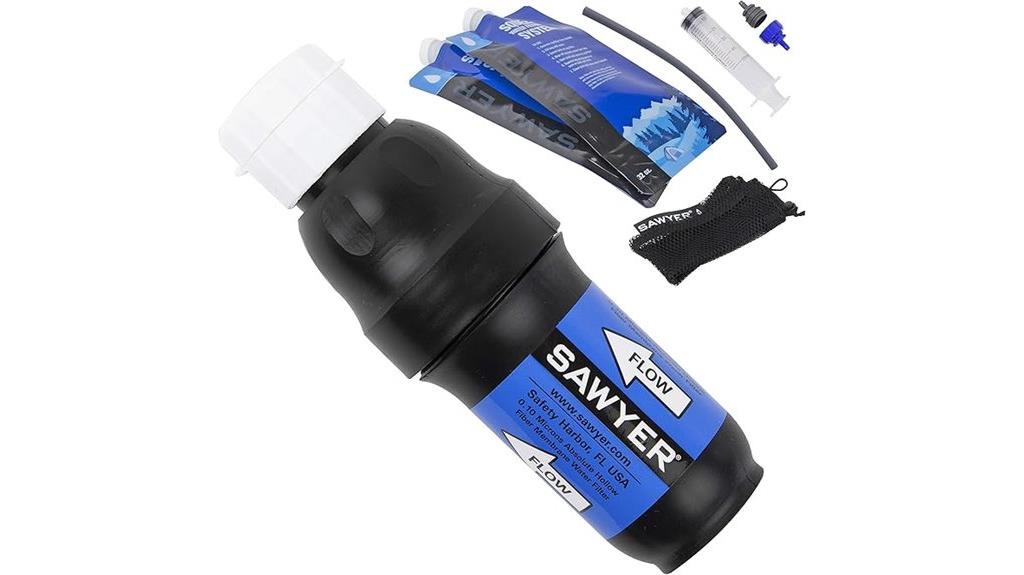
Weighing just two ounces, the Sawyer Products Squeeze Water Filtration System (SP129) delivers laboratory-grade filtration performance for ultralight backpackers who refuse to compromise on water safety. The system filters 99.99999% of bacteria and 99.9999% of protozoa while maintaining a maximum flow rate of 1.7 liters per minute. You’ll receive two 32-ounce BPA-free collapsible pouches, drinking straw, hydration pack adapters, and mesh storage bag. The 4L x 2.5W x 7.5H inch filter connects to standard 28mm water bottles and gravity systems. Each unit undergoes triple testing for reliability. Users rate it 4.7 out of 5 stars across 9,963 reviews, praising its effectiveness during hiking and camping adventures.
Best For: Ultralight backpackers, hikers, and outdoor enthusiasts who need reliable, portable water filtration without adding significant weight to their gear.
Pros:
- Exceptional filtration performance removing 99.99999% of bacteria and 99.9999% of protozoa at a fast 1.7 L/min flow rate
- Ultra-lightweight at only 2 ounces with versatile compatibility for water bottles, pouches, and gravity systems
- Lifetime warranty against defects with triple-tested reliability and outstanding 4.7/5 star rating from nearly 10,000 users
Cons:
- Does not filter heavy metals or chemical contaminants from mining or industrial areas
- Included collapsible pouches may be prone to defects and tears according to some user reports
- Lacks a protective cap for the filter when not in use, potentially allowing debris contamination
Survivor Filter PRO Hand Pump Camping Water Filtration System

When you need reliable water purification that doesn’t require batteries or complex setup procedures, the Survivor Filter PRO Hand Pump delivers consistent performance across diverse environments. At 12.8 ounces, you’ll appreciate its compact design during extended backpacking trips. The system processes 500ml per minute through gentle pumping action.
You’ll get thorough protection with 99.999% removal of viruses, bacteria, and protozoa, plus heavy metal reduction meeting NSF/ANSI standards. The BPA-free construction guarantees safe water contact. While some users report handle durability concerns, the straightforward maintenance requires no chemical cleaners. Back flushing keeps the system operational, and replacement parts remain affordable. The lifetime warranty covers manufacturing defects, providing long-term confidence.
Best For: Backpackers, campers, and emergency preparedness enthusiasts who need reliable water purification without batteries or complex setup in diverse outdoor environments.
Pros:
- Fast 500ml per minute flow rate with 99.999% removal of viruses, bacteria, and protozoa plus heavy metal reduction meeting NSF/ANSI standards
- Compact 12.8-ounce design that’s lightweight for backpacking with straightforward maintenance requiring no chemical cleaners
- Lifetime warranty covering manufacturing defects with affordable replacement parts and BPA-free construction
Cons:
- Handle durability concerns reported by some users who wish for metal components for added stability
- Requires gentle pumping action and filling 1 liter takes several minutes of manual effort
- Mixed reviews on long-term performance with some reports of loose handles affecting reliability
Factors to Consider When Choosing Water Purification Systems for Backpacking
When I’m selecting a water purification system for backpacking, I evaluate five critical factors that directly impact my trail experience and safety. Weight and portability determine how much pack space I’ll sacrifice, while filtration capacity and flow rate affect how quickly I can process water during stops. I also consider filter lifespan and ease of use, since these factors influence both long-term costs and my ability to maintain the system in challenging field conditions.
Weight and Portability
Every gram matters when you’re carrying your home on your back for days or weeks at a time. I recommend prioritizing water purification systems weighing under 16 ounces. Lightweight filter straws typically weigh 2-4 ounces, while compact gravity-fed systems range from 8-15 ounces but offer higher flow rates.
Multi-functional designs provide the best value per ounce. Systems that double as water bottles or integrate with hydration reservoirs eliminate redundant gear. Look for units with collapsible components or modular designs that compress when not in use.
Compact systems fitting into side pockets or attachment points guarantee quick access without unpacking your entire load. I prioritize systems with minimal setup requirements – no more than 30 seconds from pack to purified water. Efficient packing prevents wasted space and reduces fumbling during critical hydration moments.
Filtration Capacity Volume
Most backpacking water purifiers process between 16 ounces and 3 liters per filtration cycle, directly impacting your hydration strategy and camp efficiency. Individual-use systems typically handle 16-32 ounces per cycle, perfect for solo hikers. Group systems process 1-3 liters, accommodating multiple users efficiently.
Flow rates matter equally. Quality purifiers deliver 1-2 liters per minute, preventing bottlenecks during water collection. This speed becomes critical when multiple people need water simultaneously or you’re racing daylight.
Total system capacity varies dramatically. Some cartridges filter 100 gallons before replacement, while premium systems handle 1,000+ gallons over their lifespan. Match capacity to trip duration and group size. A weekend solo trip needs different capability than a week-long group expedition. Calculate daily water consumption—typically 2-4 liters per person—then multiply by trip days and participants.
Flow Rate Speed
Flow rate determines how quickly you’ll get drinking water from your purification system, measured in liters per minute and directly affecting your trail efficiency. Most portable filters operate between 0.5 to 2.0 L/min. Higher flow rates mean faster hydration, especially vital when filling multiple bottles or during emergencies.
I recommend checking maximum flow specifications against your specific needs. Systems achieving 1.5 liters per minute excel for group trips or rapid rehydration after strenuous climbs. However, there’s often a trade-off between speed and thoroughness. Some high-flow systems may compromise filtration effectiveness.
Consider your typical usage patterns. Solo hikers might find 0.8 L/min adequate, while groups need systems approaching 2.0 L/min. During physically demanding activities, faster flow rates become indispensable for maintaining proper hydration without excessive stops.
Filter Lifespan Duration
While flow rate impacts your immediate hydration needs, filter lifespan determines long-term system reliability and replacement costs throughout your backpacking adventures. I’ve found replaceable cartridge systems typically process 65 gallons (250 liters) before requiring replacement. Advanced ultrafiltration membranes extend this capacity dramatically, delivering up to 1,400 gallons (5,300 liters) of purified water.
Usage frequency directly affects replacement schedules. Lightweight filters need more frequent cartridge swaps during multi-day trips compared to chemical tablet alternatives. Most filtration systems process several hundred to thousands of gallons before degradation occurs.
Monitoring flow rate indicators helps track performance decline. Backwashing procedures considerably extend operational lifespan by removing accumulated debris. This maintenance prevents flow restrictions and maximizes your investment in quality filtration equipment.
Ease of Use
When you’re dealing with fatigue and challenging weather conditions, complex purification procedures can become frustrating obstacles between you and safe drinking water. I prioritize systems with minimal setup requirements that deliver immediate results. Squeeze filters require only three steps: fill, press, and drink. Water purification tablets need just dropping and waiting—no additional equipment necessary.
Clear visual separation between contaminated and clean water chambers prevents cross-contamination mistakes during stressful situations. I look for intuitive designs that allow direct filtration into standard water bottles or camping cups without adapters or complex connections.
Weight matters considerably when every ounce counts. Lightweight systems under four ounces don’t compromise your pack’s efficiency. Clear instruction labels and fool-proof mechanisms guarantee consistent performance even when you’re exhausted or operating in low-light conditions.
Contaminant Removal Types
Beyond operational simplicity, you’ll need to match your purification system’s capabilities with the specific contaminants present in your water sources. I recommend systems that remove 99.9999% of bacteria, 99.99% of viruses, and 99.9% of protozoan cysts like Giardia for extensive protection.
Ultrafiltration membranes filter particles down to 0.1 microns, effectively removing sediment and microorganisms. However, they won’t eliminate dissolved chemicals or heavy metals. Multi-stage systems combine different technologies to address broader contamination ranges, including volatile organic compounds and heavy metals through specialized media.
Activated carbon components enhance taste while removing chlorine, odors, and various chemical pollutants. Consider your purification capacity needs—this metric indicates how many gallons you can process before requiring filter replacement, which directly impacts your trip duration and maintenance schedule.
Power Source Requirements
Three distinct power source categories define water purification systems for backpacking: manual operation, gravity-fed mechanisms, and battery-powered units. Manual systems use hand pumps or squeeze mechanisms that require no external power. They’re lightweight and perfect for remote locations where you can’t rely on batteries. I recommend these for solo backpackers prioritizing weight reduction.
Gravity-fed systems harness gravitational force to process water automatically. You’ll hang the reservoir above your campsite and let physics do the work. These units can purify multiple liters simultaneously without physical effort after initial setup.
Battery-operated filters offer faster flow rates and advanced purification methods like UV sterilization. However, they add weight through battery requirements and maintenance complexity. Consider your water source accessibility and whether you prioritize speed over convenience when selecting your power source.
Durability and Construction
After determining your preferred power source, you’ll need to evaluate how well your chosen system will survive the harsh realities of backcountry use. I prioritize heavy-duty, BPA-free plastic construction that withstands repeated drops and temperature extremes. Weight remains critical—lightweight materials reduce pack burden during multi-day trips.
I examine reinforced components like metal pump handles and reinforced hose connections. These areas experience the most stress during operation and typically fail first on cheaper models. A quality system features robust threading and sealed joints that won’t crack under pressure.
I always check warranty periods before purchasing. Manufacturers offering 2-3 year warranties demonstrate confidence in their construction quality. User reviews provide valuable insights into real-world durability. Look for feedback mentioning performance after extended use in freezing conditions, high humidity, and rough handling.
Frequently Asked Questions
How Long Do Water Purification Tablets Take to Make Water Safe to Drink?
Water purification tablets typically require 30 minutes to 4 hours for complete effectiveness, depending on the active ingredient. I recommend iodine tablets, which need 30 minutes in clear water at 68°F or warmer. Chlorine dioxide tablets require 15-30 minutes for bacteria and viruses but need 4 hours for cryptosporidium. You’ll get faster results in warmer water temperatures and with pre-filtered water.
What’s the Difference Between Water Filtration and Water Purification for Backpacking?
I’ll explain the key distinction between these two water treatment methods. Filtration removes physical contaminants like sediment, bacteria, and protozoa through mechanical barriers, typically using pore sizes of 0.1-0.4 microns. Purification goes further by eliminating viruses, chemicals, and all microorganisms through UV light, boiling, or chemical treatment. Filters work instantly but miss viruses. Purifiers provide complete protection.
How Do I Maintain and Clean My Water Filter During Multi-Day Trips?
I’ll backflush my filter daily using clean water or the included syringe to remove debris buildup. I inspect the filter element for cracks or damage each morning. For ceramic filters, I gently scrub the surface with the provided brush. I’ll dry all components thoroughly before packing to prevent bacterial growth. I carry spare O-rings since they’re failure points that compromise filtration effectiveness.
Can Water Purification Systems Remove Taste and Odor From Natural Water Sources?
I’ll explain how different purification systems handle taste and odor issues. Carbon-based filters excel at removing chlorine taste, organic compounds, and musty flavors from stagnant water sources. UV purifiers don’t address taste problems since they only neutralize pathogens. Boiling eliminates bacteria but won’t improve flavor. Activated carbon pre-filters combined with purification tablets provide the best taste improvement for backcountry water sources.
What Water Sources Should I Avoid Even With Purification Systems While Backpacking?
I’d avoid stagnant pools with thick algae blooms, water with visible chemical sheens or industrial runoff, and sources near livestock operations or human waste. Don’t drink from areas with dead animals upstream or water that’s heavily discolored from mining activity. Even advanced purification systems can’t remove all chemical contaminants, heavy metals, or certain toxins that make these sources dangerous regardless of filtration capabilities.
On a final note
Selecting the right water purification system depends on your specific backpacking needs and water sources you’ll encounter. I’ve shown you systems ranging from compact filter straws to gravity-fed options and chemical tablets. Consider your group size, weight tolerance, and contamination risks when making your choice. Each system I’ve reviewed offers proven performance for different scenarios. Test your chosen system before heading into the backcountry to guarantee reliable operation.

